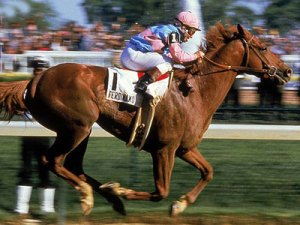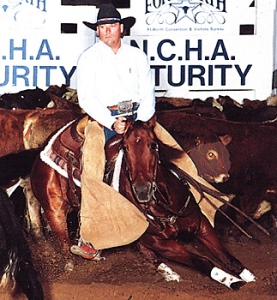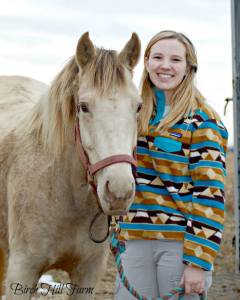On Monday, August 10th, 2015, Connecticut Draft Horse Rescue was notified by a supporter that a neglected and malnourished Clydesdale gelding was at the notorious killer auction in New Holland, Pennsylvania. The rescue responded immediately and the horse, now called Duke, was purchased and transported to CT for rehab.

Duke the former Budweiser Clydesdale, rescued in neglected condition from New Holland auction on 8/10/15.
Two days later, it was confirmed that Duke was once one of the famed Budweiser Clydesdales, who had been sold several years back to a private individual. We may never know Duke’s journey from equine royalty to killpen nobody, but his tale is a cautionary one for anyone who believes that great bloodlines or accomplishments will, in and of themselves, protect a horse throughout their lives. I’d like to relay the stories of a few horses that were not as lucky as Duke.
In 1987, the Thoroughbred racing world celebrated the awarding of Horse of the Year to Ferdinand, who had won the 1986 Kentucky Derby and 1987 Breeder’s Cup. Ferdinand was retired to stud in 1989, and in 1994 was sold to racing breeders in Japan, during a time when that country was expanding and enhancing their own thoroughbred breeding. Unfortunately, Ferdinand proved to be a less than stellar stud, and in 2002, without ever bothering to contact his breeder or former owners, the champion stallion was slaughtered for meat.
Another Thoroughbred racing great was Exceller, who despite never winning any major awards, beat two Triple Crown winners in one race! During his career, Exceller raced in France, England, Canada and the US, earning over $1.65 million. When he first retired to the breeding shed, his stud fee was $50,000. Like Ferdinand though, his offspring did not inherit their sire’s greatness. In 1991, he was sold to stud in Sweden, and after a few years was diagnosed with an infection that side-lined his breeding. Some time thereafter his owner went bankrupt and yet another elite thoroughbred died on a slaughterhouse floor. The sad fate of Exceller led to outrage amongst race fans and the founding of the Exceller Fund. It had a catalyzing effect on rescue, just as the death of Barbaro did a decade later.
It’s not just race horses that end up in these situations though, and it’s not just foreign slaughterhouses where they end up. Here we have the stories of two unrelated champion cutting horses that were neglected to death, or close to it.
First we have Millie Montana, a famed Cutting Horse champion who earned close to $140,000 in her career. She was retired to be a broodmare, and several years later was discovered on the farm of her former rider, dying from severe health issues caused by neglect, among nine other horses that died in the August Texas heat with no food or water. Millie’s condition was so severe she was euthanized a week after her rescue. Thankfully her caretakers (and I use that word loosely) were charged and convicted of neglect.
Similar to Millie, is the recent case of Dual Peppy, another World Champion Cutting Horse and high end sire. He was discovered in Colorado last year starved, standing in a manure filled stall, surrounded by the skeletons of his deceased barn-mates. In that case nine horses survived, but 14 did not.
And then there are the horses that are Champions to their owners, though they may not be famous. This is the story of Faith, who was rescued from auction last year by Birch Hill Farm, a rescue in West Virginia. The owner of the rescue had been attending a tributary auction frequented by kill buyers with the goal of saving a few lives. One of the lucky souls she bought was a uniquely colored pony mare, who was sold as an unregistered, unbroke broodmare. As it happens, she was the furthest thing from it.
Pictures of the pony, miraculously, were seen on Facebook by her former owner Emily, who had been searching for the mare ever since she learned that the woman she’d been sold to had gotten rid of her (despite a buy-back agreement). The pony had only been sold in the first place due to Emily’s father’s health issues. Faith was not an anonymous broodmare but was, in fact, a registered Quarter Pony and accomplished show hunter. Emily picked her up from the rescue a couple days later. In this circumstance, the Universe aligned perfectly to bring these two back together, but how often does it not? This just ties right into my last post, about permanent identification. It’s far too easy for horses to lose their identities, especially on the auction circuit, and that’s when they fall through the cracks.
There are millions of horses in the United States, and millions more around the world. The American Quarter Horse Association, the most commonly slaughtered breed, had 85,146 new registrations in 2014. The Jockey Club had an estimated 22,000 last year as well. That’s actually half of the 44,000 registered thoroughbreds born in 1990. Budweiser, on the other hand, breeds 30-40 horses a year. Yes, they do sell the horses that don’t fit into their breeding program, but they are generally worth quite a bit. Unfortunately that didn’t help Duke. I doubt we’ll ever know what led to his neglected condition and appearance at auction. At least, however, he is now safe, and it looks like Budweiser will contribute to his care.
While not everyone agrees with the online posting and purchase of killpen horses, it has led to the identification of a lot of horses that were missing or stolen, or that were seen by former owners or breeders who thought they were safe in forever homes! It’s hard to argue with that. Even with buy-back and first-right-of-refusal and adoption contracts, even with royal bloodlines and champion ribbons and big winnings checks, there is no guarantee that an owner might not go bankrupt, or get divorced, or end up in a psych ward or six feet under; and the horses end up starved or sold at auction. There are really no guarantees in life in general, and just like children, you can’t keep every horse in a bubble for their own protection.
Last week the Jockey Club announced that all new registered foals will be required to be micro-chipped by 2017. I think this is an excellent idea, and will hopefully lead to similar requirements in other registries and change for the horse industry as a whole. I hope it means that chip makers will streamline and coordinate their equipment so that all chips can be read by any scanner. And I hope that increased demand will bring the cost of scanners down and that every auction house and feedlot will be required to scan every horse that comes in. I hope that Stolen Horse International will be able to have an online database that those auction houses and feedlots will be required to cross-check against. And I hope that every responsible breeder and owner will have their information tagged on their horses’ chips, so that, should one of their horses end up in a bad place, they are contacted so they can help. These are the things I hope for and the things I will work toward.
Sources:
http://www.bridleandbit.com/artman/publish/article_37788.shtml
https://en.m.wikipedia.org/wiki/Ferdinand_(horse)






Finally, someone who makes sense. We have a lot of work to do for our horses, these companion animals that we have built this country with. Although their roles may have changed, our roles should not. We should be held accountable for caring for them, breeding responsibly and humanely disposing of those who can no longer live like they deserve to as a companion animal. None of them should end up on a slaughter truck, ever. And our treasured wild mustangs, the icons of American dream cars and airplanes, should be protected as intended under the 1971 law passed by Congress and never end up on a slaughter house floor at taxpayer expense. Yes, we have a lot of work to do. And no time to waste. Pass the S.A.F.E. Act. Repeal the Burns Amendment. Take care of Mother Earth.
LikeLike
EXACTLY why I will not sell any of my 4 horses. I ride a lot and 2 of them now are restricted to light riding for now. I could easily dump these 2 but absolutely will not. Buying/raising/owning horses is a commitment that few understand. So many horse owners are so unaware of the kill pipelines that exist. It is a horrible end to a horse that has worked his heart out for you to enjoy. My gift back is to never have one of my 4 end up with a bullet to his brain or knife to his spine nor left to starve neglected and lonely.
LikeLike
Reblogged this on Comedyflyer's Blog and commented:
So sad to think that a Budweiser draft horse could end up at an auction frequented by kill buyers…
LikeLike
Well said. I ended up with a horse that escaped the kill pen. I didn’t realize it when I bought him, but found out a few months later. His story is being told at tjsthebomb.com
LikeLike
Here is another nearly dreadful story of a racing thoroughbred who almost didn’t make it and a so-called rescue that turned out to be anything but. http://lancasteronline.com/news/conestoga-woman-saves-horse-from-slaughter-after-being-contacted-by/article_2af1cb08-2f84-59ca-bf54-98901df701e1.html
LikeLike
Very well put. Thank you for actually talking about a potential solution (micro chipping) instead of just pointing out how bad this is. It also nice to see someone who is aware that things happen (death, divorce, psych ward etc) and the horses fall through the cracks. I also like that you did not mention the SAFE act as a “solution” as that act will only have more horses starving in fields as it does not provide a solution to the unwanted ones. While it is wonderful to hear about horses that were saved from the kill pen, for every one that is there are another 99 without any history which cannot go to rescues etc. I as a horse professional do not like slaughter any better than the next person…however I would rather see a horse humanely slaughtered IN THIS COUNTRY than left to starve or shipped to Mexico.
LikeLiked by 1 person
My daughter saw a mare on a Facebook page that was located in a kill pen in Ft Collins, Co that we had sold. With the help of another previous owner we were able to save her. She is a distant relative of War Admiral. We now refuse to ever sell my daughters quarter pony that she has outgrown!
LikeLike
In Ireland, all horses are required to be microchipped. Maybe we should pursue that.
LikeLike
Pingback: CDHR: Duke Memorial Charity Golf Tournament | Haddam Now